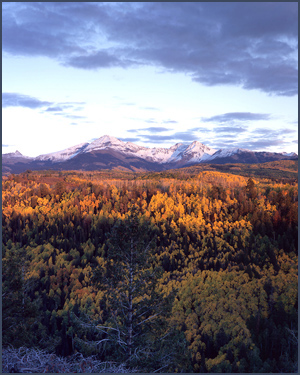Peoples of the Mesa Verde Region
The Historic Period: Late A.D. 1700s to Mid-1900sSpanish

Hesperus Peak, as it would have appeared to travelers on the Old Spanish Trail through southwestern Colorado. (See enlarged photograph.) At the beginning of the Historic period, the Mesa Verde region was still part of New Spain, the vast colonial territory that stretched north from Central America and Mexico into the American West and Southwest. Spanish rule came to an end in 1821, when Mexico declared its independence from Spain. At that time, the Mesa Verde region became a part of Mexico, but it made little practical difference to the native peoples living in the former Spanish colonies. In 1848, the region became part of the United States. Even during the early part of the Historic period, when Spain still claimed the Mesa Verde region as part of its colonial territory, there were no Spanish settlements actually in the region—instead, they were located to the east and south. From 1829 to about 1848, people of European descent—traders, slavers, trappers, and immigrants; some descended from the Spanish, others not—traveled a series of pack routes between Santa Fe, New Mexico, and Los Angeles, California, via southwestern Colorado. Known as the Old Spanish Trail, the trail network followed ancient paths that for generations had been used by various American Indian groups. In the Mesa Verde region, it generally followed the route of the Dominguez and Escalante expedition half a century before. |
|
 DONATE TODAY
DONATE TODAY
